The Hunger Games: Official Illustrated Movie Companion (13 page)
Read The Hunger Games: Official Illustrated Movie Companion Online
Authors: Scholastic,Kate Egan
Tags: #Juvenile Nonfiction, #Television & Radio, #Action & Adventure, #Juvenile Fiction, #Performing Arts, #General, #Science Fiction, #Social Issues, #Film, #Survival Stories



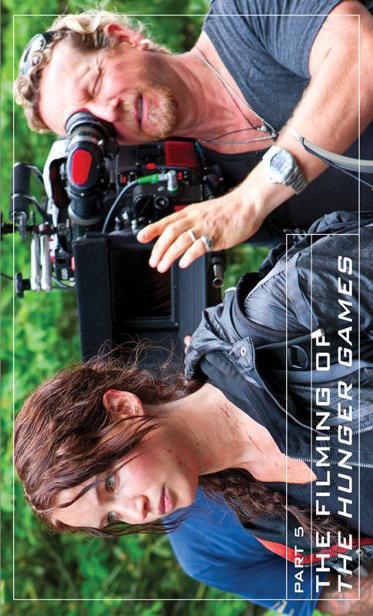
S
hooting of
The Hunger Games
started on May 23, 2011, when director Gary Ross flew to North Carolina from Los Angeles. Many of the actors were assembled there already, with more to come as larger scenes were filmed. Locations had been identified, sets had been built. Training was finished, lines were memorized. Everything was ready to go.
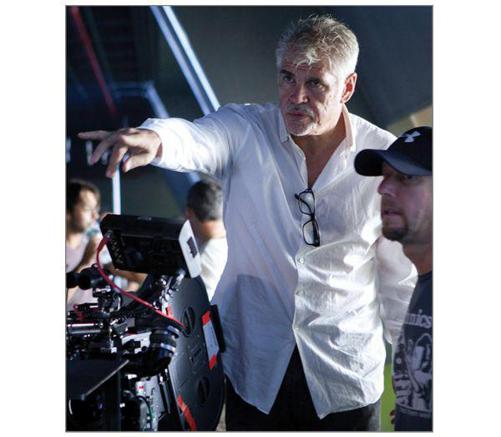
Director Gary Ross on set.
Ross had a clear sense of the way he wanted to shoot the film, and it was different from any approach he’d taken in his previous movies. “One of the things that’s most important here is to convey the immediacy, the first-person point of view that the book has. The cinematic style has to reflect that. So in this movie I got to shoot in a way that I’d never shot before — more urgent, more personal. I needed to give the audience that incredibly immediate sense that they’re not watching this girl — they
are
this girl.”
Wherever possible, then, he kept to Katniss’s point of view. “I didn’t want the audience to know more than the character knew. I wanted them to be in her shoes, to experience everything through her eyes,” Ross adds. Occasionally the film cuts away to show developments in the Capitol that will affect Katniss, or reactions back home to her performance in the Games, but for most of the movie the audience is with Katniss, filled with suspense and fear.

Ross used a handheld camera to shoot some of the pivotal scenes, giving them an intense you-are-there feeling. Nina Jacobson explains, “It’s a big movie, and at the same time we didn’t want it to be a grandiose movie. We wanted it to have a little bit of that guerrilla quality. It’s set in the future, but it’s not a movie that’s all about technology.”
While many of the young actors were new to filmmaking, they couldn’t help but notice Ross’s unusual technique. Dayo Okeniyi, who plays Thresh, says, “The fights are shot in a very gritty documentary-type style, almost like the Super Bowl. The camera gets right in there with us, and audiences are gonna feel like they are right there on the field, fighting for their lives.”
The film was shot between May and September, beginning with some of the District 12 scenes, skipping ahead to most of the arena’s action, and then returning to the Capitol scenes before and after the Games.
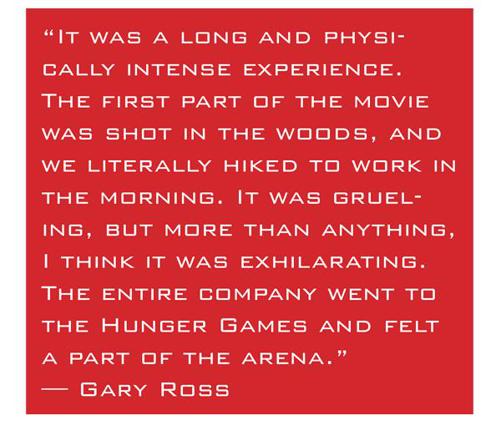
As in most movies, the scenes were not shot in chronological order, which meant that the
Hunger Games
team had to keep careful track of how the actors and backgrounds looked in each frame, to ensure continuity in the final film. It also meant that the team was moving across North Carolina, shooting in place after place, all summer long.
Alli Shearmur of Lionsgate says, “I went to North Carolina every few weeks during the filming — it wasn’t a typical situation. Gary had to make sure he had the footage he needed for every single scene, because there would be no time to reshoot later if he missed something. The movie would be in theaters in March 2012, ten months after shooting began. Because of this schedule, the production had to be unbelievably well choreographed and well rehearsed, and everybody worked long days to get what they needed there and then. They were in the woods for a long time, because they weren’t going back.”
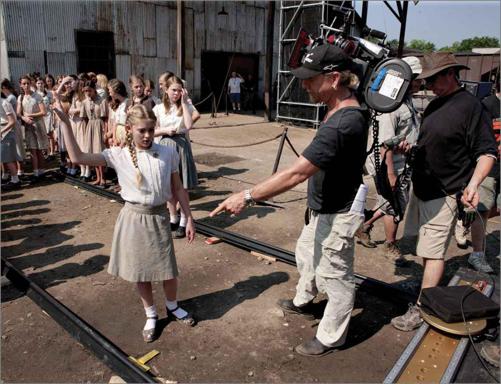
Willow Shields gets direction during the shooting of the reaping.
The actors playing the tributes had already been through training together, but filming was a different kind of experience, eerily reminiscent of the Games themselves. Producer Jon Kilik says, “Once the kids were selected and they all came together, it was not so different from the Hunger Games. They were brought into this world; they were a little suspicious of each other, a little competitive with each other. And they were performing. They had to survive. Then they slowly started to work together, get to know each other, and they really embraced and embodied their characters beautifully.”
The young actors filmed the first Cornucopia scene almost right away, and their training made it go smoothly. Their moves were choreographed ahead of time, and stunt trainers were on hand if they needed them. Putting their training into practice brought the group closer together, and made them think about the story, too.

Gary Ross and Jennifer Lawrence work on a scene in the arena.
One highlight of the shooting was a visit from author Suzanne Collins. The actors were overjoyed — and awed — to have her on hand as they filmed one of the movie’s pivotal scenes. Collins recalls, “I was on the set for Rue’s death. The scene’s so key, not only because of its emotional impact on Katniss — Rue’s essentially become Prim’s surrogate in the arena — but because it has to be powerful enough to trigger the first rumblings of the rebellion. It’s very demanding for the actors. All three of the kids — Jen, Amandla, and Jack — they gave terrific performances. T-Bone Burnett had come up with this lovely, haunting melody for the lullaby. And Gary, who was, of course, masterminding the whole thing, filmed it beautifully. There’s this one shot of Katniss cradling Rue in the periwinkle with the lush background of the forest. On the monitor it looked like an exquisite portrait, like something you’d frame and hang in a museum. I remember Amandla came and sat next to me between takes and she asked me, ‘So, what did you imagine it would be like?’ And I said, ‘Like that.’ But really, it exceeded my expectations.”
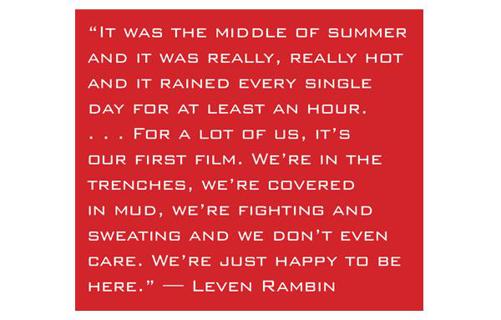
Leven Rambin, who plays Glimmer, remarks on another notable aspect of the shoot. “It was an extreme experience to be out in the middle of nowhere with no electricity or Internet service or anything. It definitely felt like you were there — like you were really there. We were really hot — just dying out there — and isn’t that really the point?”
“Our shooting schedule was crazy!” says Josh Hutcherson. “We were shooting three to four pages a day, which doesn’t sound like much, but when you realize how many shots you have to have for each one of those things, it’s an incredible amount.” Like the tributes in the Games, the actors were exhausted at the end of every shooting day. And then they had to deal with the elements.
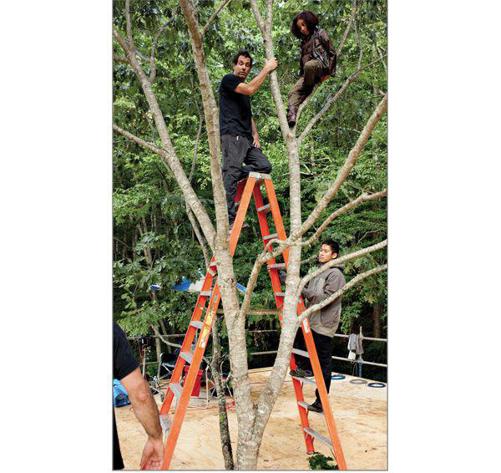
Amandla Stenberg perches in a tree with the help of a few crew members.
Summers in North Carolina are hot and humid — and wet. “We shot the arena section in state forests in North Carolina during the rainy season,” Jon Kilik says. “It rained almost every afternoon but we rarely stopped. It was a very physically challenging film.”
